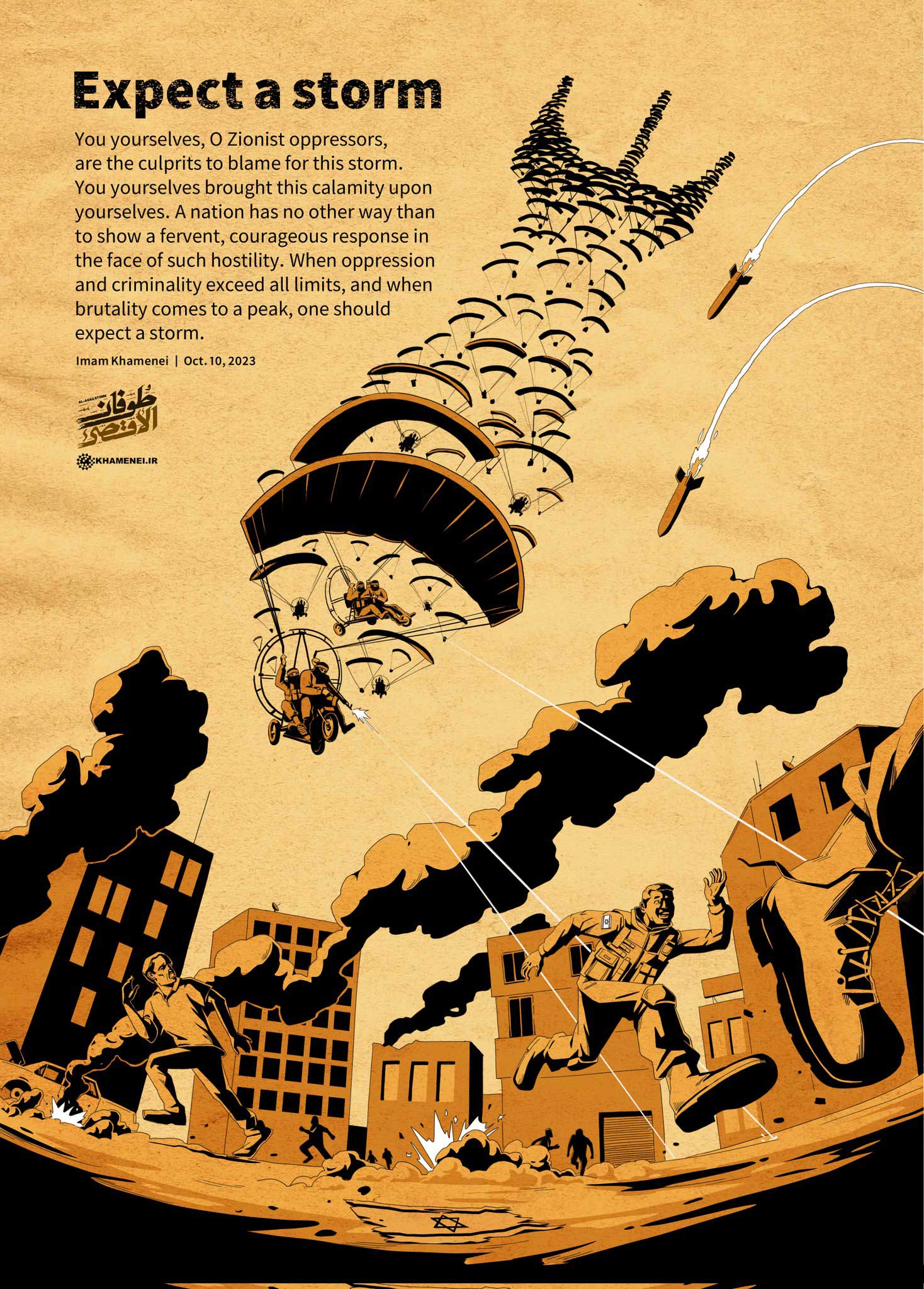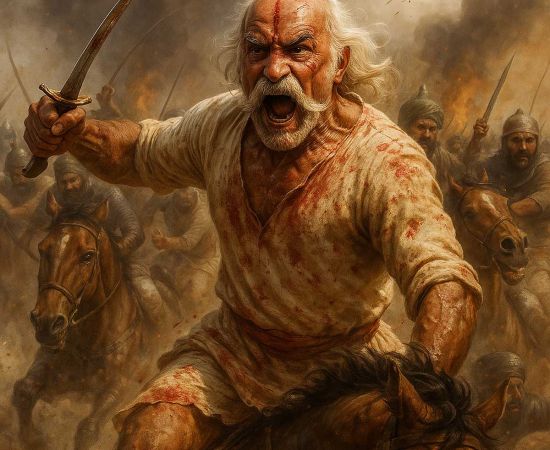MORE COVERAGE
Twitter Coverage
Satyaagrah
Written on
Satyaagrah
Written on
Satyaagrah
Written on
Satyaagrah
Written on
Satyaagrah
Written on
JOIN SATYAAGRAH SOCIAL MEDIA
"Mohammad Deif, Hamas terror architect": Unveiling the mastermind behind the deadly 'Al Aqsa Storm' operation into Israel, his extensive history of orchestrating attacks, along with Israel's decisive actions and countermeasures against Hamas terrorism

On day five of the raging Israel-Hamas war, a resounding message echoed from the skies of the Gaza Strip. The Israel Defence Forces (IDF) announced that they targeted over 200 sites in Al Furkan, one of which was the residence of Hamas military chief, Mohammed Deif's father. The aftermath bore witness to a tragic scene in Khan Yunis, where several of Deif's family members, encompassing his father, brother, and children, perished.
|
Israel's resolve is unyielding. The nation is fiercely pursuing Mohammad Deif, the brain behind numerous Hamas-led attacks. Recent IDF actions saw a barrage of rockets descend on Deif's familial abode. This aggressive airstrike specifically targeted the home of Mohammad Deif's father, located in the heart of the Qizan An Najjar neighbourhood in Khan Younis. As Palestinian reports started to flood Hebrew media, the sheer impact of the Israeli onslaught became evident. Mohammad Deif's son, brother, and the latter's granddaughter lost their lives, while other family members faced the harrowing ordeal of being trapped under debris.
Mohammed Deif, the elusive commander, remains conspicuously absent from the public eye. This enigmatic, wheelchair-bound figure is not just any leader; he's been steering the ship of Hamas's military faction since 2002. Israel's intelligence agency, Mossad, has repeatedly tried to corner him, but Deif, with an uncanny knack for survival, has always evaded their clutches. With every narrow escape, he cements his position as one of Israel's most sought-after adversaries.
Mohammed Deif, a name that often evokes mystery and intrigue, has earned his reputation as a “shadowy” figure in the labyrinth of Middle Eastern geopolitics. Notably, he's been a proverbial 'cat with nine lives', eluding multiple assassination attempts by Israel. While officially taking the helm as Gaza's commander of Hamas's military wing in July 2002, Deif's notoriety had long cemented him atop Israel's "most wanted" list.
The current tumult ignited when the Palestinian militant faction Hamas unleashed an unparalleled assault on Israel on October 7. Since then, the region has been embroiled in violence of staggering proportions. As of Monday, the casualty toll surpassed 1,100, with countless others nursing injuries on both sides of the conflict.
The escalating situation witnesses not only Hamas but also another group, the Islamic Jihad, deepening the crisis. Both groups, in a brazen move, have taken over 130 individuals from within Israel's borders, relocating them to Gaza. The underlying motive? To orchestrate an exchange – these hostages for the release of thousands of Palestinians incarcerated by Israel.
The tempestuous winds of conflict in the Middle East once again capture global attention. With Mohammed Deif, the leader of Hamas's military wing, anchoring "Operation Al-Aqsa Storm," questions linger. The operation, Deif cites, is an outcome of the "16-year blockade of Gaza, the enduring Israeli occupation, and the chain of recent events that have supercharged Israeli-Palestinian tensions." However, the man behind this operation remains an enigma, frequently painted as the "shadowy" figure in the narrative.
|
A Glimpse into Mohammed Deif's Past
Deif's leadership of Hamas's military wing dates back to 2002. Yet, a dive into his earlier life, as profiled in the Financial Times, uncovers a storied history. Born Mohammed Diab Ibrahim al-Masri in the 1960s, Deif's early life unfolded in the Khan Younis refugee camp in Gaza. This was a time when Gaza was under Egyptian governance, spanning 1948 to 1967. The subsequent chapters saw Gaza transition under Israeli rule from 1967 to 2005, only to later be governed by the Palestinian Authority from 2005 to 2007. The tableau altered in 2007 when a Hamas coup firmly planted its flag in Gaza's political landscape.
Historical anecdotes suggest a lineage of resistance, as either Deif's uncle or father reportedly engaged in the 1950s raids by Palestinian armed forces into areas akin to those infiltrated by Hamas fighters recently. Deif's journey also intersected with academia when he enrolled at the Islamic University of Gaza.
Such glimpses offer insights into the man central to the ongoing upheaval, a figure as complex as the conflict he now spearheads.
Mohammed Deif and His Intricate Role in Hamas | Founded in the late 1980s, Hamas emerged during the first Palestinian intifada. This uprising was a reaction to Israel's occupation of the West Bank and Gaza Strip, territories they had captured during the 1967 Israeli-Arab War. The organization, born from resistance, would soon find one of its most influential figures in a young man in his 20s at the time - Mohammed Deif.
Journey to Leadership: Through Bars and Battles During this tumultuous period, the Financial Times indicates that Deif's activism didn't go unnoticed by Israeli authorities. His suspected involvement in organizing suicide bombings, particularly the devastating wave in 1996, which resulted in the loss of more than 50 civilian lives, saw him imprisoned by the Israelis. These bombings were not random acts of violence but were perceived as retaliatory moves against the Oslo Peace Accords.
Signed in the early 1990s, the Oslo Peace Accords between Israel and the Palestine Liberation Organisation (PLO) sought to carve a pathway towards Palestinian self-determination. This would culminate in the creation of a Palestinian state, peacefully co-existing with Israel. However, for Hamas and Deif, the Accords were a bone of contention. Their opposition was rooted in history. The 1948 Arab-Israeli war had seen Israel taking control of Palestinian territories. For Hamas, the Oslo Peace Accords represented a formal relinquishing of these territories, a move they staunchly opposed.
In the midst of political turmoil and amidst divergent perspectives, Mohammed Deif's influence within Hamas grew, his actions echoing his beliefs and shaping the course of the conflict.
According to the Financial Times, Deif was mentored by Yahya Ayyash, also known as the "Engineer". Ayyash, infamous for his bomb-making skills, met his untimely demise in 1996 when Israel orchestrated his assassination using an explosive-laden mobile phone.
Deif's Ascent within Hamas With such a prominent figure as his mentor, Deif's ascent within the Hamas hierarchy was almost inevitable. He soon found his footing within the Qassam Brigades, the militaristic backbone of Hamas.
However, such prominence came with perils. Long before Deif officially assumed the role of Gaza commander of Hamas's military wing in 2002, he was on Israel's radar — topping their "most wanted" list. The BBC reports several narrow escapes from Israel's determined efforts to end his influence. One such attempt in 2002 saw Israeli helicopters unleashing missiles on a vehicle near Gaza City, resulting in the tragic demise of two Hamas members and leaving behind a trail of destruction with at least 40 injured, including 15 children.
A Marked Man Deif's strategies and influence weren't limited to Palestinian territories. The US State Department labeled him as a terrorist, acknowledging his pivotal role as the mastermind behind Hamas's offensive strategy during the 2014 Israel-Hamas conflict. Israel, too, recognized the gravity of his influence. In a chilling episode the same year, they targeted Deif in an airstrike. Although Israel's objective remained unmet, the strike devastatingly claimed the lives of Deif's wife and seven-month-old son.
In the volatile landscape of Middle-Eastern politics, Deif's journey is a testament to the intense interplay of strategy, survival, and sacrifice.
 |
| Khamenei Media | @Khamenei_m | Expect a storm #AlAqsaStorm #Palestine |
The "Bulletproof Legend" of Hamas
The resilience and continued survival of Mohammed Deif, despite the looming threat of Israel's relentless attempts to assassinate him, has only strengthened his enigmatic status. As per Ronen Bergman, a seasoned Israeli journalist with a focus on security affairs, Deif stands as a unique military figure in the annals of Hamas. The New York Times encapsulated Bergman's perspective: “Deif is the only prime military figure in Hamas to have survived so long. The fact that he was able to escape multiple assassination attempts and recover from severe injuries has built him the image and prestige of a bulletproof legend.”
These relentless attempts, however, did not come without their toll. According to the Financial Times, the many brushes with death left Deif physically altered — he's wheelchair-bound after reportedly losing an arm and a leg. To add to the grim list, certain factions contend that he has also been deprived of an eye.
The Israeli officers, as stated in the Financial Times report, revealed more about Deif's strategic acumen. He consistently sought high-impact targets — from settlers and soldiers in the occupied territories to buses in the bustling cities of Jerusalem and Tel Aviv. Deif's strategy was not merely about immediate retaliation but a broader vision. The report accentuated Deif's dissent within Hamas against periodic ceasefires in exchange for humanitarian aid, emphasizing his unwavering stance against Israel and his undiluted vision for Hamas's future.
|
|
Amid the Israel-Palestine conflict, Gaza’s 100-year history of war
The land of Gaza, nestled by the azure Mediterranean, carries in its sand the imprints of history, bravery, and bloodshed. For over a century, its landscape has borne witness to countless conflicts, from the biblical era to the present-day Israel-Palestine confrontations.
In January 2018, amidst the bustle of New Delhi, a poignant moment connected the battlefields of Gaza to the heart of India. Israel's Prime Minister Benjamin Netanyahu stood shoulder to shoulder with Indian Prime Minister Narendra Modi. Together, they honored the valor of the Indian soldiers at Teen Murti Haifa Chowk, a tribute to the Battle of Haifa in Israel.
Yet, Haifa's glory was not the only notable chapter in India's connection to the Palestine campaign. A few steps from the newly christened Teen Murti Haifa Chowk, the tales of another fierce battle resonated — a prelude to Haifa.
A decade earlier, in the gritty terrains south of Haifa, another saga of heroism had unfolded. This was the Third Battle of Gaza in November 1917. The Indian lancers and Gurkha riflemen, exemplifying bravery, played an instrumental role in this pivotal battle. Their adversaries? The formidable Ottoman forces under the command of German General Kress von Kressentstein, along with the Yildirim Army Group, helmed by the astute Erich von Falkenhayn. The former Prussian Minister of War and Chief of the German General Staff led an Ottoman unit interspersed with the German Asia Corps.
|
|
The victory in Gaza, a testament to the might and camaraderie of the Empire and Indian forces, set the stage for subsequent victories in the region, with the Battle of Haifa being one of the crowning jewels.
In essence, while Haifa shines as a beacon of India's overseas military accomplishments, it is essential to recognize that the path to that glory was paved earlier, on the sands of Gaza, where courage, sacrifice, and history melded under the scorching sun.
A slender stretch of land, Gaza has historically been the center of geopolitical turbulences and military strategies. Notably, the Imperial Service Cavalry Brigade, a unit punctuated with valiant Indian soldiers, carved its mark into this territory, pushing through Gaza and forcing the formidable Ottoman forces to a hasty retreat. This act of bravery was not just a military feat but sowed the seeds of India's enduring relationship with the region.
To many Indians, the term 'Gaza Strip' resonates differently. Known colloquially as "Gaza Patti" or the 'strip of Gaza', it's a minuscule yet densely populated patch, flanked by Israel, Egypt, and the Mediterranean. A staggering 2 million Palestinians call this 365 sq km area their home, making it one of the planet's most populated zones.
But the Gaza Strip's significance isn't just in its demographics. Together with the West Bank, it forms the backbone of the State of Palestine. Signifying its commitment to the Palestinian cause, India was among the first nations to recognize the State of Palestine in 1988. By 1996, a representation of this bond was established with India opening an office in Gaza. Though later moved to Ramallah in 2003, the very heart of the West Bank and Palestine's administrative capital, the sentiment remained untouched.
|
Fast forward to February 2018, the tapestry of India-Palestine ties was adorned with another milestone. Narendra Modi, the Indian Prime Minister, embarked on a historic journey, becoming the first from his office to set foot in Palestine. Welcomed by President Mahmoud Abbas, Modi's visit, punctuated by his homage at Yasser Arafat's mausoleum in Ramallah, was more than a diplomatic gesture. It was a reaffirmation of India's deep-rooted ties and respect for Palestine's struggles and aspirations.
Gaza, with its vast tapestry of historical events, has seen many rulers and, with them, shifting boundaries. From the clutches of the mighty Ottoman Empire, to the British, Egyptians, and finally the Israelis, the strategic relevance of this territory has been the subject of countless wars, political maneuvers, and diplomatic deals.
After the Ottoman Empire's downfall, the British occupation of Gaza began in 1918. However, the 1948 Arab-Israeli War, marking the close of the British Mandate for Palestine, saw Gaza falling under Egyptian control. Despite an attempt by Cairo to establish the All-Palestine Government, it remained largely an Egyptian puppet. This facade came to an end in 1959, when the Egyptian President Gamal Abdel Nasser dissolved the puppet regime, bringing the Gaza Strip directly under Egyptian rule.
However, geopolitical tensions in the region never eased. In 1967, as Arab nations appeared to unite against it, Israel took a preemptive step, launching a military campaign against its neighbors. A blitzkrieg of sorts, Israel's air and ground forces swiftly captured the Gaza Strip and Sinai Peninsula from Egypt, the West Bank from Jordan, and the Golan Heights from Syria. This Six-Day War ended with Israel cementing its military superiority in the region.
|
Yet, the shadows of war persisted. The 1973 Yom Kippur War saw Israel caught off-guard, but it managed to fend off the Arab coalition. The aftermath of this conflict led to introspection even within Israel; the realization dawned that an eternal war footing was unsustainable.
This acknowledgment facilitated a shift in the political climate of the Middle East. With Egypt realigning its alliances, diplomatic negotiations gained momentum, culminating in the 1978 Camp David Accords. A landmark agreement, it saw Israel consenting to withdraw from Sinai in return for Egypt establishing diplomatic relations. More importantly, the Accords laid down the framework for Palestinian autonomy, recognizing the rights of the Palestinian people and proposing an autonomous governing entity for Gaza and the West Bank.
The path to peace, however, remains fraught with complexities. Even as diplomatic treaties were inked, the ground realities of Gaza and its neighboring regions remained as tangled as ever.
The aftermath of the Camp David Accords saw the world honor the peacemakers, with Egypt's President Anwar Sadat and Israel's Prime Minister Menachem Begin receiving the Nobel Peace Prize in 1978. But peace was fragile, and the Egypt-Israel peace treaty of 1979 stirred the pot of Middle Eastern geopolitics, enraging Palestinians and leading the Arab League to ostracize Egypt. The region's volatility was further underlined by Sadat's assassination in 1981 at the hands of radical Islamists from the Egyptian Islamic Jihad.
Personal stories often intertwine with the larger tapestry of geopolitics. One such story is that of Yonatan "Yoni" Netanyahu, elder brother to Benjamin Netanyahu. Yoni, a figure of valor in Israel, led elite forces in crucial battles, including during the Yom Kippur War against Syrian positions in the Golan Heights. His bravery and leadership came to a tragic end during the Entebbe raid in 1976, where he lost his life in a mission to free hostages from Palestinian and German hijackers in Uganda.
As the 1990s approached, another significant step towards peace was initiated with the Oslo Accords of 1993 and 1995. These Accords facilitated the establishment of the Palestinian National Authority, granting the Fatah-controlled administration governance over sections of the West Bank and Gaza. This semblance of stability, however, was short-lived. In 2006, Hamas, an organization with its roots in armed resistance against Israel, unexpectedly won the elections. This militant group, founded in 1987, quickly upset the status quo. By 2007, they had successfully expelled Fatah, an organization co-founded by the legendary Yasser Arafat, from Gaza. With this move, they asserted their dominance over the Strip, setting the stage for further complexities in the Israel-Palestine dynamic.
|
Gaza exit plan
In the complex saga of the Israeli-Palestinian relationship, the year 2005 marks a significant gesture of peace from Israel. Under the leadership of Prime Minister Ariel Sharon, Israel undertook the Gaza Disengagement Plan, a bold initiative that called for the unilateral withdrawal of all Israeli settlers and military personnel from the Gaza Strip, while also vacating select settlements in the West Bank. This action, aiming at peace, was met with contentious views both within Israel and across the globe.
Israel's internal political dynamics saw this decision splitting opinions sharply. Benjamin Netanyahu, then a pivotal member of the Likud Party and an influential adversary of Sharon, expressed profound reservations about the plan. By August 2005, showing deep-rooted concerns for the nation's security, Netanyahu resigned from the government. His resistance stemmed from the belief that relinquishing Gaza without reciprocated assurances could endanger Israel's national security. He presciently cautioned that this unilateral move might inadvertently strengthen extremist factions like Hamas and Islamic Jihad.
In the spirit of compromise and hope, Israel went ahead with the disengagement. This involved the painstaking process of dismantling established Israeli settlements and relocating around 9,000 Israeli citizens. The Israeli defense forces also withdrew, marking a significant effort to make way for Palestinian self-governance. However, a careful and security-centric approach was maintained, with Israel, under the Oslo agreements, keeping oversight over Gaza's airspace and territorial waters.
The disengagement was Israel's leap of faith, hoping that the Palestinians would embrace the opportunity for peaceful self-rule. However, the subsequent ascendancy of Hamas and the continuation of aggression reignited concerns over Israel's security, validating the apprehensions of those who had been wary of the disengagement in the first place.
|
The uncertain road
The Gaza Strip's recent actions have once again highlighted the existential threats faced by the State of Israel. Despite Israel's consistent attempts to forge peace, including the unilateral withdrawal from Gaza in 2005, the region has remained a hotbed of militant activities, constantly endangering Israeli lives.
Post-2007, the necessity of a blockade became evident due to the security risks posed by unchecked border crossings. Israel’s efforts to safeguard its citizens are often mischaracterized by some in the international community. While terms like "open-air prison" are thrown around, the crux of the matter is Israel's genuine security concerns, which have been repeatedly validated by indiscriminate rocket attacks from Gaza.
Prime Minister Benjamin Netanyahu's commitment to protecting Israeli lives has come to the fore in these testing times. Hamas’ blatant aggression, marked by unrelenting rocket barrages, leaves Israel with no choice but to defend itself. With every rocket launched from Gaza, it becomes abundantly clear that Israel is not dealing with a partner for peace but an organization with a dangerous and violent agenda.
While Israel exercises utmost caution to avoid civilian casualties, the same cannot be said for Hamas, which is known to use its own population as human shields. Israel's potential ground response, though risky, may be a necessary step to neutralize the entrenched threats and ensure long-term security.
The Abraham Accords, a diplomatic beacon of hope in the region, are now under threat from Hamas and its allies. Their actions seem geared not only towards terrorizing Israel but also destabilizing these crucial peace agreements. This goes to show that the underlying intentions of the Gaza-based militants aren't just anti-Israel but anti-peace, posing a challenge not only to Israel but to the broader aspirations of the Middle East.
 Support Us
Support Us
Satyagraha was born from the heart of our land, with an undying aim to unveil the true essence of Bharat. It seeks to illuminate the hidden tales of our valiant freedom fighters and the rich chronicles that haven't yet sung their complete melody in the mainstream.
While platforms like NDTV and 'The Wire' effortlessly garner funds under the banner of safeguarding democracy, we at Satyagraha walk a different path. Our strength and resonance come from you. In this journey to weave a stronger Bharat, every little contribution amplifies our voice. Let's come together, contribute as you can, and champion the true spirit of our nation.
 |  |  |
| ICICI Bank of Satyaagrah | Razorpay Bank of Satyaagrah | PayPal Bank of Satyaagrah - For International Payments |
If all above doesn't work, then try the LINK below:
Please share the article on other platforms
DISCLAIMER: The author is solely responsible for the views expressed in this article. The author carries the responsibility for citing and/or licensing of images utilized within the text. The website also frequently uses non-commercial images for representational purposes only in line with the article. We are not responsible for the authenticity of such images. If some images have a copyright issue, we request the person/entity to contact us at satyaagrahindia@gmail.com and we will take the necessary actions to resolve the issue.
Related Articles
- American media house CBS downplays the horrific reality of ISIS crimes, claiming a Yazidi woman was merely ‘stranded’ in Gaza, despite being trafficked by ISIS, held captive by Hamas terrorists, forcefully married, and turned into a sex slave for 10 years
- Amidst a backdrop of joy at the Supernova festival, Hamas terrorists descended from the sky and turned celebration into massacre, the haunting tragedy of Shani Louk and the abduction of Noa Argamani embody the heartbreak, here is what all we know so far
- "Securing Lives, Challenging Terror": Israel nears a strategic breakthrough with Hamas, negotiating the release of hostages in a move that underscores its resolve and commitment to its people amid a tense, decades-long conflict in the Middle East
- "Behind every shield, a heart still beats": As the Hamas-Israel conflict intensifies, innocent Israeli babies confront horrors beyond imagination, amidst fragile diplomatic efforts, these souls are caught in a war's crossfire, bearing heart-wrenching toll
- "Condemn terror, champion peace": India denounces Hamas terrorism while supporting Palestinians civilians, advocates for a balanced two-state resolution, and engages in proactive Middle East diplomacy to ensure lasting regional peace and security
- "Foul Zenith": In a chilling strategy, Hamas holds Gaza captive, using residents as shields, as the conflict rages, 50000 pregnant women put forth for emotional leverage; meanwhile leaked plans unveil Hamas's intent to maximize innocent Israeli casualties
- "Fading Star's Fumbles": Mia Khalifa, hailed for her 'talents' on adult platform, tried geopolitics with laughable naiveté, leading Playboy and Canadian broadcaster to exit ties, her 'expertise' on Hamas and India shows a comedic disconnect from reality
- "World Must Witness Truth": Israel screens 44-min unedited raw footage of Hamas' Oct 7 massacre, revealing confessions of targeting Jews and incentives for abducting women and children, the video aims to counter Hamas 'denial of the chilling atrocities'
- "Shattered Peace": In a harrowing incident, a French school witnesses horror as a lad shouting #AllahuAkbar takes life of a teacher & injures many, attack aligns with Hamas call for 'Global Day of Jihad', France grapples with terror amidst rising tensions
- "It is a fight between Muslimeen and Kafireen": In Assam, IIT-Guwahati students Tauseef Ali Farooqui & Sohail Ur Rahman in the spotlight after Farooqui's LinkedIn letter pledges allegiance to ISIS deepens investigations into radical activities on campus
- "War unchosen, the outcome unforeseen; Israel stands firm": Iran-backed Houthis in Yemen escalate conflict by declaring war on Israel, launching missiles and drones at Eilat, prompting a robust response from the IDF with advanced interception technology
- Alarm bells ring as ISI backs a new plot against India! Farhatullah Ghori, the notorious architect of the 2002 Akshardham attack, now shielded by Pakistan's ISI, emerges in provocative video, rallying Indian Muslim youth to rise and wage war against India
- Publishing house The Hindu, in its English magazine 'FrontLine' officially endorsed Hamas violence, justifying brutal acts of terrorism as victimhood, this stance potentially lays the groundwork for future genocides in the name of vengeful holy war
- "Hamas rockets: missing Israel, finding Gaza": Evidence mounts towards a tragic revelation, Hamas in an alarming misjudgment, had inadvertently launched a rocket that grievously impacted Gaza's very own Al-Ahli al-Arabi Hospital, inflicting its own people
- "Harvard latest course: How to lose billionaires 101": As the Harvard university's stance on a pro-Hamas letter sparks debate, luminaries like Idan Ofer and Wexner Foundation cut all the ties, Harvard's once-untouchable prestige now faces serious scrutiny



























